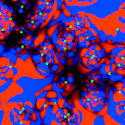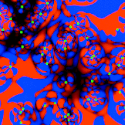Fractals and quantum criticality
Unlike classical transitions, which involve thermal fluctuations, quantum phase transitions are driven solely by quantum fluctuations and occur when a parameter, such as density or magnetic field, is varied at zero temperature. Signatures of this zero-temperature transition—quantum critical behavior—can be seen even at finite temperature.
While it is possible to describe quantum critical states of bosons using Monte Carlo methods, a similar approach for fermions is a major challenge. The reason is the famous minus sign that appears in front of the wave function for fermions when the fermions are interchanged. As a result, the amplitudes of these wave functions cannot be interpreted as probabilities—a problem that worsens with decreasing temperature.
Writing in Physical Review B, Frank Kruger and Jan Zaanen of the University of Leiden in the Netherlands address the physics of fermionic quantum criticality by applying a path-integral formalism that encodes fermionic statistics as a geometric constraint on a bosonic system. How does a bosonic system store information about the Fermi energy—a quantity that applies uniquely to fermions? The geometric constraint takes the form of a nodal hypersurface that confines particles to pockets whose size is related to the Fermi energy. At a zero-temperature critical point, the size of these pockets vanishes, which, for instance, makes the quasiparticles in a heavy-fermion system infinitely massive, and gives rise to scale invariance—a signature of fractal behavior—of the nodal surface.
The authors show how this fractal behavior would influence the thermodynamic response functions of liquid , a fermionic fluid. The results could potentially be applied to understanding quantum critical behavior in heavy-fermion metals and high-temperature superconductors. - Sarma Kancharla





